Basic Principles of Classical Ballet (7 page)
Read Basic Principles of Classical Ballet Online
Authors: Agrippina Vaganova

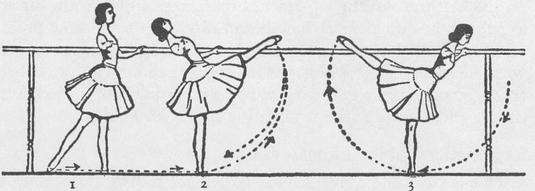
13. Grand battement jeté balancé
In the 2nd position battements jetés balances may be used only in the centre, not at the barre, and it acquires a different form. The leg thrust into 2nd position is supplanted through 5th position by the other leg in 2nd position. As the legs are quickly interchanged, the body bends each time to the side of the supporting leg.
BATTEMENTS FRAPPÉS
The starting point of the right leg is in the 2nd position, with the toes pointed. The right foot beats the left one sur le cou-de-pied front and returns to the 2nd position, hitting the floor with the pointed toe. The accent is in the 2nd position.
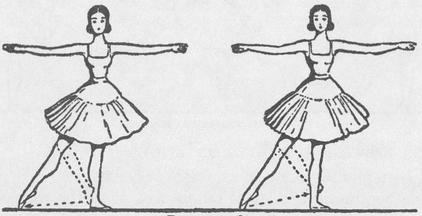
14. Battement frappé
Sur le cou-de-pied front is the position of one foot on the ankle of the other one. The sole, with the instep stretched out and the toes lowered, grasps the ankle. Sur le cou-de-pied back: the instep and toes in the same position, but the side of the heel and ankle are pressed against the standing foot from behind
15
When battement frappé is done back, the foot does not beat sur le cou-de-pied, but passes behind the ankle.
This form is used in the elementary study of the movement.
In the more advanced classes when battement frappé is done on the half-toe and the leg reaches the 2nd position in the air at 45° the same accent must be felt and directed to the same point of the 2nd position; the knee must be taut and springy, the contact with the left leg a short beat, the leg should rebound like a rubber ball. The upper part of the leg must be immobile and turned out; the leg must work without vibrating in the knee-joint.
BATTEMENTS DOUBLES FRAPPÉS
This is the same movement as battement frappé, but the foot does not beat the left leg in the front only once. It is transferred in a second passing beat sur le cou-de-pied back. From there it opens to the side, into the 2nd position. If the first beat is done back, then the second passing beat is done front.
PETITS BATTEMENTS SUR LE COU-DE-PIED
In the starting position the right foot is sur le cou-de-pied. It opens in the direction of the 2nd position, but only halfway, because the leg is not fully extended at the knee. Then it is transferred back, touching the left leg at the ankle, and opens again in the same manner, and returns front.
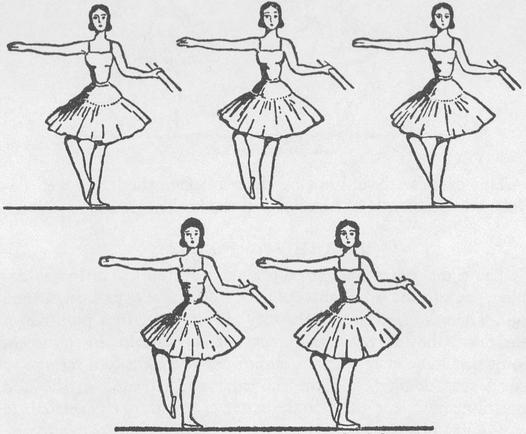
15. Petit battement sur le cou-de-pied
At the beginning of the study petits battements should be done without any accent.
At the moment of the transfer of the foot, attention must be paid that the instep is not shortened, that the sole does not bend.
The upper part of the leg from the knee to the hip must be firm, immobile, fully turned out and the lower part must do the movements freely. At the change to fast tempo, the opening of the leg gets shorter. But it must never fade and turn into a smear. Although the transfer of the foot from cou-de-pied front to the back is almost imperceptible to the eye, this movement should never lose its precision, and requires the same articulate execution as if done in slow tempo.
BATTEMENTS BATTUS
The starting-point is sur le cou-de-pied. From here the right foot does a number of short swift strokes on the heel of the left foot in the position sur le cou-de-pied front. The stroke should be done with the toe; the lower part of the leg should move freely.
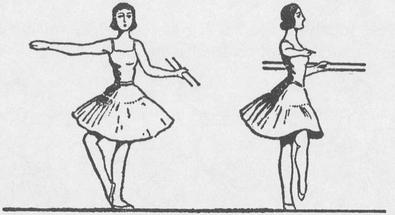
16. Battement battu
This exercise should not be started before the leg is well developed. Usually, it is done only in the higher grades.
BATTEMENTS FONDUS
The right foot moves from the 5th position to sur le cou-de-pied, the left one simultaneously does a demi-plié, its knee turned out. Then the right leg opens forward with the toes pointed on the floor, the left one straightens out and extends in the knee-joint simultaneously with the right one. The right foot returns to sur le cou-de-pied, and the movement is repeated in the 2nd position and to the back. In the latter case the foot passes sur le cou-de-pied back.
Attention must be paid that in this battement the knee is not raised and the leg is not lifted. These two things are done only when the exercise is performed with the legs at an angle of 45° or 90°.
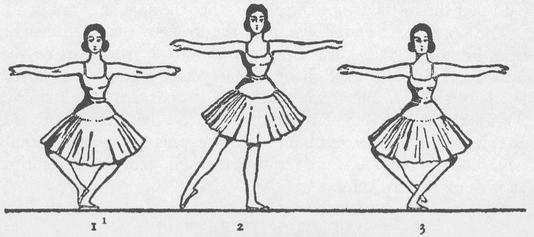
17. Battement fondu
16
In the grand and petit développé the legs should be turned out as carefully as in battements tendus. For example, in doing the movement back attention should be paid that the knee is not dropped, and that the upper part of the leg is well turned out.
This movement belongs to the category of more complicated exercises, because the leg on which the dancer stands also participates in the work, doing a plié simultaneously with the battement done by the other leg.
BATTEMENTS SOUTENUS
From the 5th position the right leg is taken out to the front, into the 2nd position, or to the back, the left leg simultaneously doing a plié. Then the left foot rises on the half-toe, the right leg is drawn to the left one, and both of them join in the 5th position on the half-toe.
From this point the movement is either repeated or is done to the other side. The leg that is being taken out should not be bent or raised too high (if the movement is done on the floor, and not at an angle of 45° or 90°).
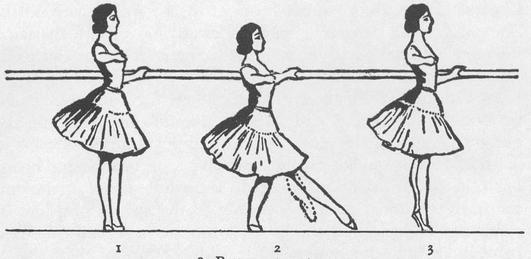
18. Battement soutenu
BATTEMENTS DÉVELOPPÉS
From the 5th position the sole of the lifted right foot with toes pointed glides over the left leg up to the knee and opens in

19. Battement développé
the required direction, keeping the knee and the heel in a turned-out position.
If the lifted leg is not brought up to the knee, the movement looks careless. On reaching the extreme point (90°), the leg is lowered into the 5th position.
This movement is included in exercises in numerous variations:
1.With the extended leg being bent so that the toes touch the supporting knee, from which the extension is repeated;
2. With little movements of the extended leg, lowered slightly and re-lifted to 90°; these movements should be attempted with the toes only, so that the leg is not brought down too low, but just slightly swings;
3. The leg, extended forward, is drawn with a swift movement into the 2nd position and is brought to the front again, all in one count, with the accent on the forward movement; the same movement to the back; the same movement from the 2nd position forward and back.
4. With turns of the body. Do développé forward, make half a turn on the supporting leg into 2nd arabesque and return on the same leg, rotating the raised leg. In 2nd position: do développé in 2nd position, quickly change onto that foot, turning and opening other leg into 2nd position; do the whole figure again, and return to the initial position opening the leg in 2nd position. In changing the hands on the barre, grasp the barre with the free hand and change it simultaneously with the turn of the body.
Développé is a movement from adagio. Slow tempo is inherent in développé, and it should be performed with a retardation at the extreme point, especially in the lower grades.
The leg on which the dancer stands should be fully extended, like a taut string, the knee fully turned out. The arm which rests on the barre should be freely bent at the elbow. Particular attention must be paid to this when the forward movement is performed. Frequently the arm is strained, thus furnishing support for the leg. It is easier to stand in this manner, but the exercise under these conditions is useless.